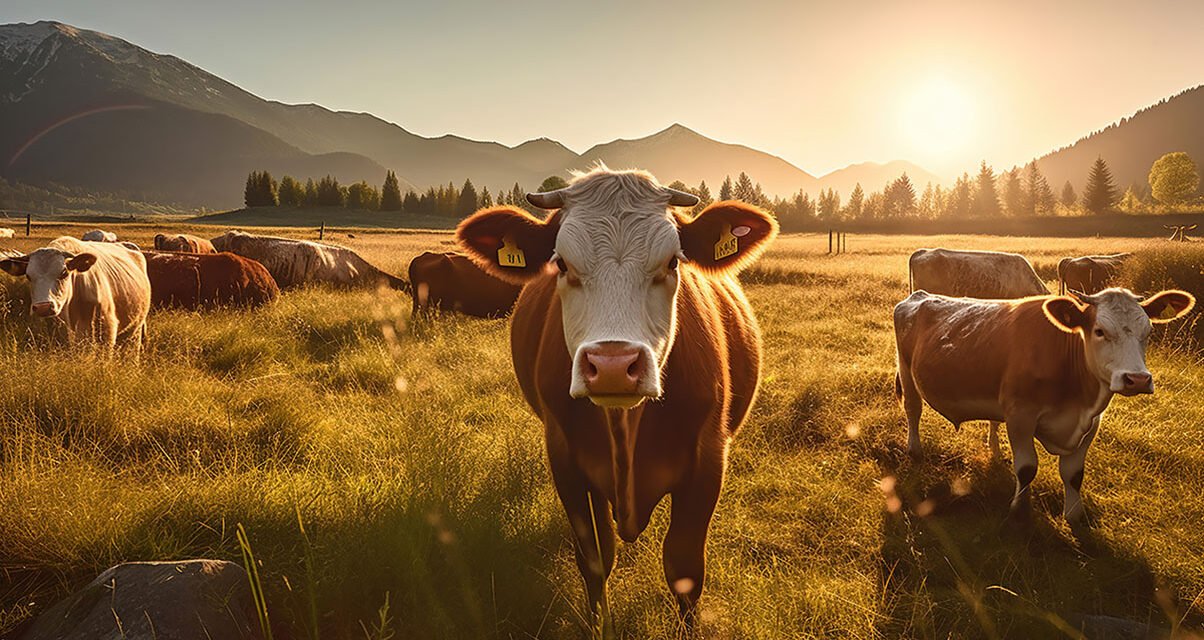Climate change is a global crisis that demands urgent attention and action. Widely recognized as one of the most pressing challenges of our time, with its far-reaching consequences affecting ecosystems, economies, and societies. While multiple factors contribute to climate change, one significant and often overlooked link is the relationship between climate change and meat production and consumption. This post delves into the intricate connection between climate change and meat, exploring the environmental implications of meat production, its role in exacerbating climate change, and potential solutions to mitigate its impact.
Climate Change And Meat Production, The Environmental Implications
The modern meat production industry, particularly the intensive livestock farming systems, has a substantial environmental footprint. The process of raising animals for meat requires vast amounts of natural resources, including water, land, and feed. Deforestation, primarily to create grazing areas and grow animal feed crops, leads to habitat loss and contributes to a decline in biodiversity. In addition, the excessive use of water and land for animal agriculture puts pressure on already scarce resources and can lead to soil degradation and water pollution. Here are the significant implications of meat production.
I. Increased Greenhouse Gas Emissions
The production of meat has a significant and undeniable impact on greenhouse gas emissions, making it a prominent contributor to global climate change. The intricate relationship between meat production and greenhouse gas emissions underscores the urgency of addressing this issue to mitigate the adverse effects of climate change. Here are a few ways in which meat production affects greenhouse gas emissions and the broader implications for our planet.
Methane Emissions from Livestock:
Livestock, particularly ruminants like cattle, sheep, and goats, play a pivotal role in meat production. However, they also emit methane—a potent greenhouse gas—during their digestion process. This methane releases through a process called enteric fermentation. This process is microbes in the animals’ stomachs that break down food. Methane is more effective at trapping heat in the atmosphere than carbon dioxide over a shorter time frame, which makes it a particularly concerning contributor to global warming.
Manure Management
Animal waste, including manure, is another significant source of greenhouse gas emissions in meat production. Improper handling and storage of manure can lead to the release of methane and nitrous oxide—both potent greenhouse gases—into the atmosphere. These emissions occur during manure decomposition, storage, and application to agricultural fields.
Deforestation and Land Use Change
Expanding meat production often involves clearing land for grazing or growing feed crops. This process contributes to deforestation and land use change, which have profound implications for greenhouse gas emissions. Trees store carbon dioxide, and during deforestation, stored carbon discharge into the atmosphere. In addition, the process of deforestation reduces the Earth’s capacity to absorb carbon dioxide, amplifying the greenhouse effect.
Energy Intensive Supply Chain
The entire supply chain of meat production, from animal husbandry to processing, transportation, and distribution, requires significant energy inputs. These energy-intensive processes rely on fossil fuels, leading to the emission of carbon dioxide and other greenhouse gases. Refrigeration, packaging, and transportation of meat products to consumers also contribute to the carbon footprint of the industry.
Implications of Climate Change And Meat Production

The impact of meat production on greenhouse gas emissions has far-reaching consequences for climate change. Here are three to consider.
1. Global Warming
The release of methane and carbon dioxide from meat production contributes to the overall greenhouse gas concentration in the atmosphere. This traps heat and leads to global warming, causing changes in climate patterns, rising sea levels, and extreme weather events.
2. Positive Feedback Loops
As the Earth warms, certain feedback loops activate, further exacerbating the problem. For example, thawing permafrost releases stored methane, amplifying the greenhouse effect.
3. Biodiversity Loss
The expansion of meat production often leads to habitat destruction and biodiversity loss, reducing the planet’s capacity to regulate greenhouse gas concentrations naturally.
4. Deforestation and Land Use Change
As demand for meat rises, more land mass is liable for both grazing and growing animal feed crops. This expansion often involves deforestation, particularly in regions like the Amazon rainforest. Trees play a crucial role in sequestering carbon dioxide, so deforestation not only releases stored carbon into the atmosphere but also eliminates a vital mechanism for reducing atmospheric carbon levels.
II. Water Consumption and Pollution Associated With Climate Change And Meat Production
Meat production is not only a significant contributor to greenhouse gas emissions and deforestation, but it also exerts substantial pressure on water resources and can lead to water pollution. The intricate relationship between meat production, water consumption, and pollution highlights the urgent need for sustainable practices to mitigate these environmental challenges.
Water Intensity of Meat Production
Meat production is remarkably water intensive compared to other forms of food production. The process of raising livestock, providing them with water, and growing feed crops requires vast amounts of freshwater. Also, the processing, transportation, and cleaning involved in meat production contribute to the overall water footprint of the industry. Here are examples of the excessive use of water.
Feed Crops and Irrigation
A large portion of water consumption associated with meat production is also responsible for the cultivation of feed crops, such as soybeans and corn. These crops require irrigation, which can lead to over-extraction of water from rivers, lakes, and aquifers. In regions with water scarcity, the cultivation of feed crops for livestock further exacerbates the strain on local water resources.
Animal Water Needs
Livestock require substantial amounts of water for drinking, cleaning, and cooling. Ensuring the well-being of animals in intensive farming systems often involves providing them with consistent access to water. However, this demand for water can also put pressure on local water supplies and contribute to resource depletion, especially in areas prone to drought.
Water Pollution from Runoff and Waste
Water pollution is another significant consequence of meat production. The waste generated by animals on farms, including manure and chemicals, can leach into water bodies through runoff. This contamination leads to nutrient pollution, which can trigger harmful algal blooms, deplete oxygen levels in water bodies, and harm aquatic ecosystems. In addition, nutrient pollution, pathogens from livestock waste, can contaminate water sources, posing risks to both human health and aquatic life.
Eutrophication and Dead Zones
Excessive nutrient runoff from animal farms contributes to eutrophication—a process in which nutrients, primarily nitrogen and phosphorus, stimulate the excessive growth of algae in water bodies. As these algae die and decompose, they consume oxygen, leading to the formation of oxygen-depleted “dead zones” where aquatic life struggles to survive. This phenomenon disrupts aquatic ecosystems and negatively impacts fisheries and other water-dependent industries.
Implications of water usage to ecosystems and Human Health

The implications of meat production on water resources and pollution have far-reaching consequences
1. Ecosystem Degradation: Excessive water consumption and pollution can lead to the degradation of aquatic ecosystems, harming aquatic biodiversity and disrupting ecological balance.
2. Human Health: Water pollution from livestock waste and chemicals can contaminate drinking water sources, posing risks to human health through waterborne diseases and the ingestion of harmful substances.
3. Loss of Water Security: In regions already facing water scarcity, the intensive water use associated with meat production can exacerbate water insecurity for both communities and ecosystems.
Mitigation Strategies to avoid water pollution
To address the water-related implications of meat production, we can pursue several strategies:
1. Sustainable Farming Practices: Implementing better waste management techniques and promoting practices that reduce water use, such as efficient irrigation and water-efficient animal housing, can minimize the impact on water resources.
2. Reduced Meat Consumption: Encouraging a shift towards plant-based diets or reduced meat consumption can lower the demand for livestock and reduce the overall water footprint of the industry.
3. Regulations and Standards: Governments can implement and enforce regulations that limit water pollution from agricultural activities and promote responsible water use.
4. Investment in Technology: Advancing technologies that improve water efficiency in livestock farming and enhance waste treatment can mitigate the impact of meat production on water resources and pollution.
One potential Solutions to overcome hazards associated with meat production climate change

Addressing the connection between meat consumption and climate change requires a multi-faceted approach. Besides plant-based meats, here are other potential solutions:
1. Reduced Meat Consumption
Encouraging individuals to adopt a more plant-based diet. This can significantly reduce the demand for meat, decreasing the environmental impact associated with meat production.
2. Sustainable Farming Practices
Implementing sustainable and regenerative agricultural practices can minimize the environmental harm caused by intensive livestock farming. This includes rotational grazing, optimizing feed efficiency, and managing waste.
3. Alternative Protein Sources
The development and promotion of alternative protein sources, such as plant-based proteins and cultured meat, offer a more environmentally friendly way to meet protein demand without the same level of resource consumption and greenhouse gas emissions.
4. Policy and Regulation
Governments can play a crucial role in mitigating the impact of meat production on climate change by implementing policies that promote sustainable agriculture, discourage deforestation, and incentivize the adoption of more climate-friendly practices.
Summary
The connection between climate change and meat production is a complex and multifaceted issue that demands attention at various levels. We cannot overlook the environmental implications of meat production, greenhouse gas emissions or deforestation and water consumption. As individuals, industries, and governments grapple with the challenge of mitigating climate change, recognizing the role of meat consumption and production is an essential step. We must look towards crafting effective and sustainable solutions for a more resilient planet. By adopting responsible methods, we can achieve more sustainable results. Our action can reduce our carbon footprint by lower consumption patterns, promote sustainable practices, and embrace innovative solutions. We can work towards a future where the link between meat and climate change is not what it is today. The ultimate result being a healthier planet for current and future generations.
Related: Meat Production and Consumption: Environmental Consequences








